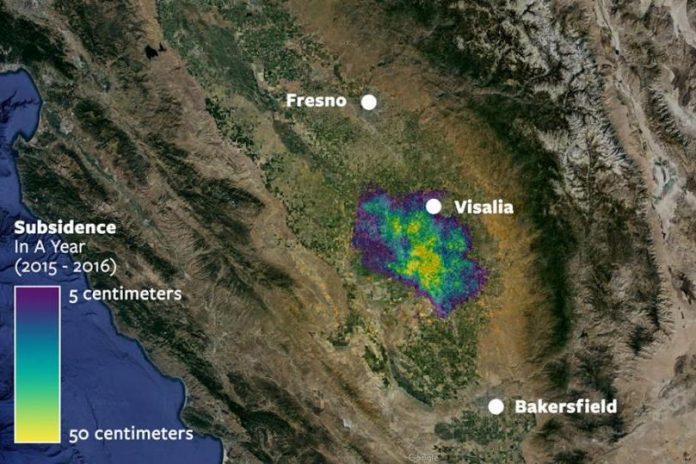
Aug. 31 (UPI) — New research suggests Central California’s San Joaquin Valley is once again sinking at an alarming rate, as groundwater is drained faster than it can be replenished.
Between October 2011 and September 2015, California experienced its driest four-year spell since scientists began tracking precipitation totals in 1895. Heavy rains in early 2017 offered farmers a brief respite, and helped municipalities replenish reservoirs.
New analysis suggests the rebound is no more and subsidence is back.
“With the heavy storms in early 2017, Californians were hopeful that the drought was over,” Kyle Murray, a doctoral candidate in the field of geophysics at Cornell University, said in a news release. “There was a pause in land subsidence over a large area, and even uplift of the land in some areas. But by early summer the subsidence continued at a similar rate we observed during the drought.”
The San Joaquin Valley is one the United States most productive agricultural regions. Farmers there have relied on the Tulare Basin’s groundwater for decades. Winter rains and spring snowmelt partially replenish the valley’s aquifers, but drought conditions during the last decade have shrunk the underground water supply, causing the valley’s land — which supports the weight of surrounding mountains — to sink.
Between 1962 and 2011, the San Joaquin Valley aquifers shrank by a half cubic-mile every year. Satellite data showed the groundwater volume shrank by 10 miles cubed between 2012 and 2016. The latest analysis suggests the region’s underwater aquifers continue to shrink at an accelerated rate.
Scientists shared their analysis of California’s ground water depletion and subsidence in the journal Science Advances.
The problem is multifaceted. The shrinking underground water puts pressure on the region’s farms, which account for 8 percent of the United States’ agricultural output and earn $17 billion annually. The sinking land puts pressure on local infrastructure. Subsidence causes sink holes and encourages cracks in roads and building foundations.
Sinking land can also make it harder to move waters to where it’s needed most — compounding the impacts of prolonged drought.
“One of the places where it really matters in California is the aqueduct system that brings water to the region. They’re engineered very carefully to have the correct slope to carry a given amount of water,” said Rowena Lohman, Cornell associate professor in earth and atmospheric sciences. “Now, one of the major aqueducts in that area is bowed and can’t deliver as much water. It’s been a huge engineering nightmare.”






